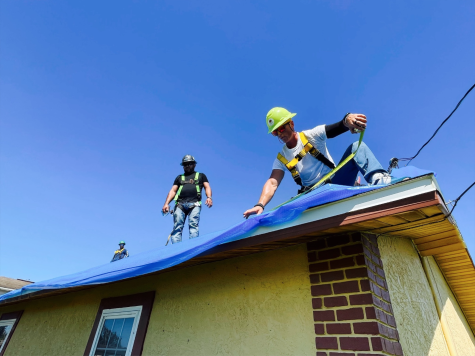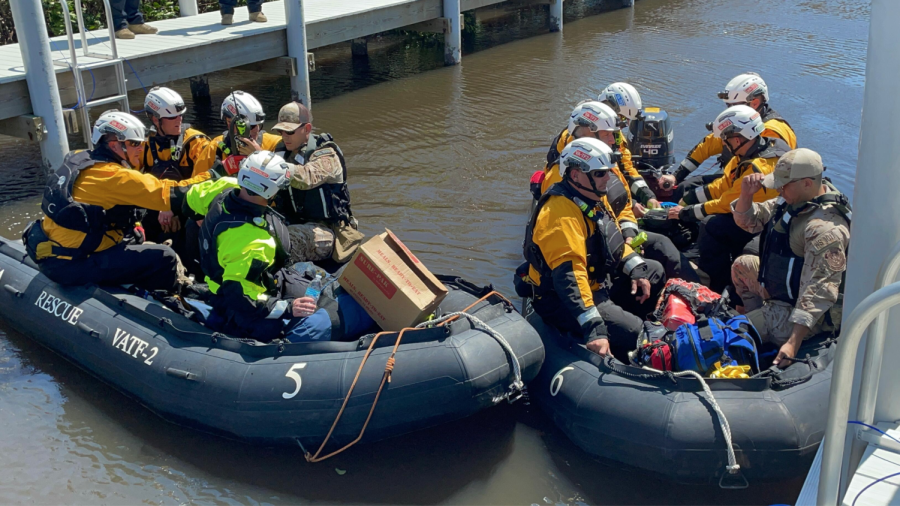Hurricane Ian strikes coast of Florida, wrecking homes and ravaging communities
Hurricane Ian, a Category 4 storm, hit Florida on Sept. 28 and destroyed parts of its western coast, causing damages costing up to $67 billion in repairs.
First spotted when and has since moved and expanded, Hurricane Ian became the strongest hurricane to hit Florida since Hurricane Michael in 2018, generating over 10 inches of rainfall and extreme winds. Currently, at least 119 people in Florida have died due to Hurricane Ian, and more than 6,800 residents are staying in emergency shelters.
Across Florida, the hurricane has had different impacts on people in various areas. Sophie Grace (10), who has friends living in the state, talked about their current situation.
“[One of my family-friends] was planning on building a second house, near the shore,” Sophie Grace said. “When the hurricane hit, the entire house got gutted, but thankfully the structure was still intact. Some houses were destroyed in that area, but luckily no house was completely gone.”
In other areas, damages were more extreme, with the high surges near the Fort Myers Beach area leaving buildings partially submerged underwater and houses completely decimated. People across the coast are suffering major wreckage, with nearly 850,000 residents without power since five days after the storm started.
According to a 2020 Proceedings of the National Academy of Sciences (PNAS) study, as of 2017, 38% of the tropical cyclone activity on the planet was classified as “major intensity,” defined as a Category 3 storm, with wind speeds between 111 and 129 mph, Category 4 storm, with wind speeds ranging from 130 to 156 mph, or a Category 5 storm, where wind speeds are 157 mph or above. Hurricanes in the North Atlantic reached a similar rate of 42%. The increase in hurricanes, according to upper school biology teacher Jeff Sutton, can largely be attributed to global warming.
“Hurricanes are first determined by the sun, which drives a lot of weather,” Sutton said. “Second, the Earth’s rotation causes the Coriolis Effect. [This] makes the airflow and heating and cooling of the Earth’s surface to cause winds and the movement of air and wind, creating a hurricane. As they pick up temperature as they move through the tropics, they warm up, and the warm water helps them. Warm air and water means more energy, which means more intense storms.”
As global warming worsens, oceans will continue to absorb 90% of heat waves produced by rising greenhouse gas emissions. This effect increases the ocean’s average temperature, making hurricanes more likely to occur.
While hurricanes such as Ian leave behind detrimental effects, Sutton explains that they can be beneficial to the environment as well, specifically through the Intermediate Disturbance Hypothesis. The Intermediate Disturbance Hypothesis explains that at levels of moderate disturbance in environments, higher diversity will occur.
“Diversity is a good thing,” Sutton said. “If you think of it in a way, some sort of stress on the ecosystem is good; not too much or too little, but just that ‘Goldilocks happy medium’ amount. And that tends to make more niches — more niches means more habitat diversity, more habitat diversity tends to mean more species diversity, [creating] different plants, fungus, bacteria and animals.”
Florida previously experienced major housing deficits, with a shortage of 500,000 homes in the state that are affordable for low and middle-income families, and Hurricane Ian has only worsened the situation, leaving many more without a home.
As welfare checks and rescue missions continue in Florida and South Carolina, the number of missing individuals is decreasing. Florida First Lady Casey DeSantis announced on Monday that over $45 million has been raised from 62,000 different donors for Hurricane Ian relief, and as of now, the Federal Emergency Management Agency (FEMA) has provided more than $420 million to assist survivors. Additionally, fire departments all over California have sent crews to Florida to support search and rescue, and California Governor Gavin Newsom has also chipped in by deploying a team of mass care experts to help facilitate shelters. However, even with these efforts, many people still remain largely homeless.

“At first the news made it seem like [Florida’s government] is handling the situation well, but then after you realize there’s still a lot of people who don’t have any homes right now, it’s really a bad situation for them to be in,” Sophie Grace said. “It’s got to suck for everyone who doesn’t have a home, and the government isn’t able to provide them with one.”

Vika Gautham (11) is the co-features editor for Harker Aquila and the Winged Post, and this is her third year on staff. This year, Vika wishes to provide...

Victor Gong (12) is an Editor-in-Chief for the Winged Post, and this is his fourth year on staff. This year, he hopes to experiment with unique page designs,...


















![“[Building nerf blasters] became this outlet of creativity for me that hasn't been matched by anything else. The process [of] making a build complete to your desire is such a painstakingly difficult process, but I've had to learn from [the skills needed from] soldering to proper painting. There's so many different options for everything, if you think about it, it exists. The best part is [that] if it doesn't exist, you can build it yourself," Ishaan Parate said.](https://harkeraquila.com/wp-content/uploads/2022/08/DSC_8149-900x604.jpg)




![“When I came into high school, I was ready to be a follower. But DECA was a game changer for me. It helped me overcome my fear of public speaking, and it's played such a major role in who I've become today. To be able to successfully lead a chapter of 150 students, an officer team and be one of the upperclassmen I once really admired is something I'm [really] proud of,” Anvitha Tummala ('21) said.](https://harkeraquila.com/wp-content/uploads/2021/07/Screen-Shot-2021-07-25-at-9.50.05-AM-900x594.png)







![“I think getting up in the morning and having a sense of purpose [is exciting]. I think without a certain amount of drive, life is kind of obsolete and mundane, and I think having that every single day is what makes each day unique and kind of makes life exciting,” Neymika Jain (12) said.](https://harkeraquila.com/wp-content/uploads/2017/06/Screen-Shot-2017-06-03-at-4.54.16-PM.png)








![“My slogan is ‘slow feet, don’t eat, and I’m hungry.’ You need to run fast to get where you are–you aren't going to get those championships if you aren't fast,” Angel Cervantes (12) said. “I want to do well in school on my tests and in track and win championships for my team. I live by that, [and] I can do that anywhere: in the classroom or on the field.”](https://harkeraquila.com/wp-content/uploads/2018/06/DSC5146-900x601.jpg)
![“[Volleyball has] taught me how to fall correctly, and another thing it taught is that you don’t have to be the best at something to be good at it. If you just hit the ball in a smart way, then it still scores points and you’re good at it. You could be a background player and still make a much bigger impact on the team than you would think,” Anya Gert (’20) said.](https://harkeraquila.com/wp-content/uploads/2020/06/AnnaGert_JinTuan_HoHPhotoEdited-600x900.jpeg)

![“I'm not nearly there yet, but [my confidence has] definitely been getting better since I was pretty shy and timid coming into Harker my freshman year. I know that there's a lot of people that are really confident in what they do, and I really admire them. Everyone's so driven and that has really pushed me to kind of try to find my own place in high school and be more confident,” Alyssa Huang (’20) said.](https://harkeraquila.com/wp-content/uploads/2020/06/AlyssaHuang_EmilyChen_HoHPhoto-900x749.jpeg)



